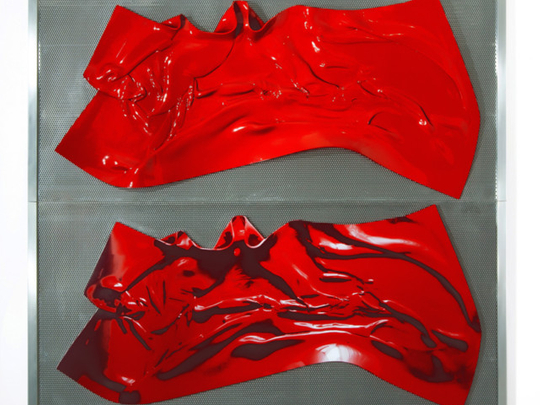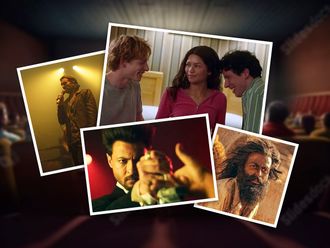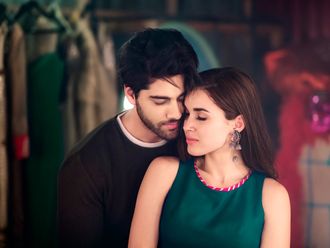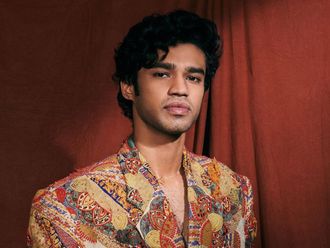
Skyler Brickley began his artistic journey as a figurative painter. But he felt the need to find another way to capture the changes taking place around him in an environment of economic recession, growing terrorism and evolving technologies. In his latest show, “Meltdown”, the New York-based American artist has used molten plastic to create abstract sculptures that quite literally and metaphorically represent the global financial and social meltdown.
“To reflect the present global situation and the way people are feeling today I wanted to create artworks that conveyed a sense of something being pulled apart. After experimenting with various materials I was able to create that effect with plastic or PETG (Polyethylene Terephthalate Glycol) of a certain thickness. I used a vacuform oven to melt sheets of clear plastic, and pulled and twisted the hot, molten mass to create these abstract shapes. The sculptures were then painted with automotive paints in an automotive workshop. The method, materials and process I use are an important part of my work,” Brickley says.
The industrial process and materials he uses celebrate the creative possibilities of modern manufacturing methods. But they also highlight the ever-increasing industrialisation and consumerism in society and its effect on the environment. Brickley’s warped and contorted sculptures also allude to bombed buildings and mangled cars, pointing to the violence that continues more than a decade after 9/11. He often creates surface textures on the pieces or layers them with patterns and images to mimic the layering of Photoshop manipulations. Thus his sculptures are an abstract representation of the present social, political and economic environment as well as of technological innovation and the history of the digital revolution.
But while the artist comments on the world around him, he also looks inward to reflect on his own journey. For instance, a diptych titled “Golden Rice” features a distorted red plastic sculpture placed next to a flat object, which cut in the same shape and imprinted with an image of the sculpture forms a self-referential mirror image. The two pieces are framed within a perforated stainless steel panel. The perforations are a reference to the Benday dot used for tonal shading in the classical printing process. The dots were a recurring motif in Brickley’s early paintings and connect his plastic sculptures with his earlier work, while referencing the history of art and technology.
The dots also appear in another work, “Grey Goo”, where they are imprinted on to the plastic. Looking like pixels they symbolise the shift from analogue to digital and look into the future at the possible consequences of new technologies. “Today when industrial processes are being replaced by digital technologies such as 3-D printers, I imagined a scary scenario where 3-D printers start printing themselves without control, creating endless replicas and using up all the world’s resources,” the artist says.
Jyoti Kalsi is an arts enthusiast based in Dubai.
“Meltdown” will run at Mottahedan Projects, Al Quoz, until December 15.
BOX
A Celebration of Pop Art
By Jyoti Kalsi
Opera Gallery is hosting an exhibition of paintings and sculptures by Miami-based Brazilian artist Romero Britto and French artist Laurence Jenkell. Both have instantly recognisable signature styles. Jenkell is known for her sculptures of wrapped candies or Bonbons. And Britto combines elements of cubism, fauvism and street art to create his Neo-Pop paintings and sculptures, filled with very bright colours, bold lines and smiling faces.
Art lovers around the world are familiar with Britto’s work because he has done many commissions for leading brands and companies. He has been invited to paint on new models of fancy cars and on the deck of a ship, design labels for beverage bottles, paint Disney characters and design stamps for the UN. And his sculptures and murals can be seen at places such as New York’s JFK airport, Hyde Park in London and the O2 Dome in Berlin.
Explaining his cheerful themes and animated compositions, Britto says, “For me the most important thing is to create art that celebrates the simple and good things in life. I had a difficult childhood in Brazil, and that inspires me to create ‘positive’ or ‘optimistic’ art that makes the world happy. My work appeals to people of all backgrounds and cultures because everybody wants to be happy and to feel good by seeing things around them that are bright and beautiful. And everybody can identify with my motifs of red hearts, the smiling ‘boomfish’, couples in love, cats, dogs and fairytale characters such as Snow White.”
The candy has always been Jenkell’s favourite subject. In her early work she used real sweets on her canvases. Later she developed her unique technique of twisting heated Plexiglas to create her Bonbon wraps. In 2011 she created a series of large candy sculptures printed with the flags of the G20 countries for the G20 summit in Cannes.
“A candy signifies desire, an object of pleasure and sweet memories of childhood,” Jenkell says. But she has transformed it into a medium that reflects modern society. While candies covered with flags or chessboards speak about identity and power games, the candies with lace-like patterns are inspired by today’s fashion trends; and a candy with a DNA molecule wrapped around it, titled ‘Skeleton’, reflects existential concerns as well as scientific advances. The show also features the artist’s latest experiments with new materials such as metal and marble.
The show will run at Opera Gallery, DIFC, until December 17.












